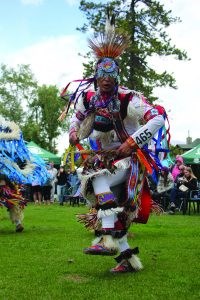
Wearing traditional regalia, members of the Bighorn Chiniki Stoney Nation danced to the steady beat of a drum to mark National Aboriginal Day, June 21.
The powwow attracted hundreds of onlookers who assembled on the front lawn of the information centre to learn about Jasper National Park’s indigenous history.
Supt. Alan Fehr and Mayor Richard Ireland both spoke during the ceremony, but it was the surprise appearance by Chief Jim O’Chiese from the Foothills Ojibway First Nation that had the most profound impact on the crowd.
Dressed in white with an eagle feather headdress he shared a message of peace and co-existence and reminded the crowd that his ancestors called Jasper home for thousands of years before Europeans arrived.
“Everyday is Aboriginal day for me because that’s who I am,” said O’Chiese.
“I’m not a newcomer and I’m not a visitor to Jasper National Park, we used to be here.”
He urged the crowd to live in co-existence and learn from one another.
“First Nations were always making treaties with one another nation to nation before European contact so we already knew how to live in coexistence,” O’Chiese said in a follow up interview.
“Fast forward to the time when the treaties were made with the Queen of England, it was to share this land, to coexist and to learn from one another.”
Earlier in the afternoon, Ireland reminded the crowd that Jasper National Park is located in Treaty 6 and Treaty 8 territories as well as in the traditional territories of the Beaver, Cree, Ojibway, Shuswap, Stoney and Metis nations.
“Jasper has an enduring tradition as a gathering place. An important aspect of that tradition is the long connection with Indigenous peoples,” said Ireland.
“Long before today’s community gatherings, before regional, national and international tourism appeal, long before the European explorers and adventurers of yesteryear, Indigenous people gathered at this confluence of rivers and valleys under the shadow of these very same mountains.”
He said many of the park’s place names and landmarks continue to bear the names originally ascribed to them by the First Nations, such as Athabasca, Chaba and Poboktan.
“We may never know the full extent of the First Nations presence in this treaty and traditional area, but we can acknowledge it is immemorial,” said Ireland. “Several years ago, along what is now known as the Overlander Trail, which is just north of our town an arrow head was discovered and was established to be about 8,000 years old, indisputable evidence that these trails and valleys have provided access to this gathering place for Indigenous peoples for millennia.”
Wrapping up his speech he delivered a message of peace, hope and reconciliation.
"We have a shared past, we will have shared future, what we need most is a shared understanding of each,” said Ireland. “Lets use this gathering, the celebration of National Aboriginal Day, to reflect on how we may use our shared past to best shape our shared future.”
Supt. Fehr’s speech was significantly shorter, but he too touched on Parks Canada’s efforts to improve its relationships with Indigenous people across the country.
“There is no relationship more important to the government of Canada than the one with the Indigenous people, and as a agency Parks Canada has a responsibility to work in a respectful fashion to build strong and lasting relationships with our Indigenous partners across the country,” said Fehr. “I am very proud of the nation to nation building that has taken place at Jasper National Park through the Jasper Indigenous forum as we constantly try and renew Canada’s relationship with Indigenous peoples.”
Paul Clarke
[email protected]
